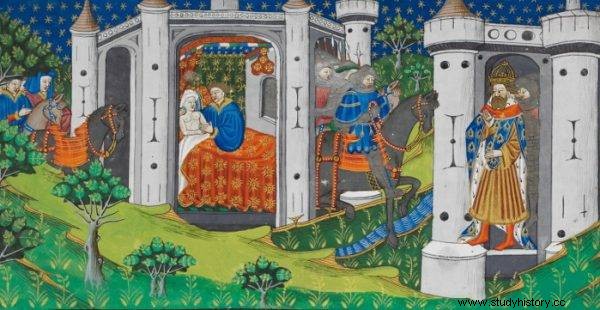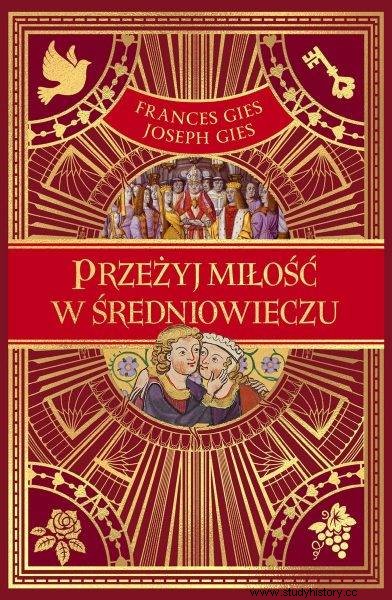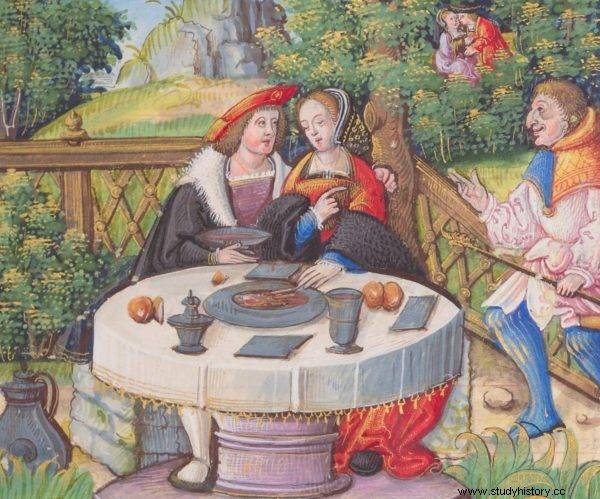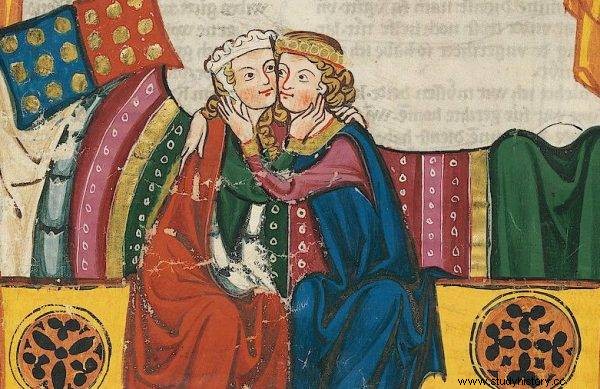The question of who can marry and have sex with whom has always been a pressing issue. But the answers were different. What was considered incest in the Middle Ages?
Endogamy and the inevitably accompanying incest have been taboo since the dawn of time. People almost always got married or got married "outside the family." The rules governing the permissible kinship of spouses were strictly defined, although ... not always the same . In fact, the rules have changed dramatically and unpredictably over the centuries. Similarly, as are the views on what exactly this kinship is. As they write in their latest book Experience love in the Middle Ages Frances and Joseph Gies:
Some societies do not recognize illegitimate children as the rightful offspring of their parents' families; others - on the contrary. In some cultures, adoption implies a legal, though unnatural, extension of the family. Other kinds of relationships, whether spiritual or ritual, such as with godparents or with sworn members of a fraternity, are sometimes considered to be a kind of relationship governed by the same prohibitions as those relating to marriage to "real" relatives.
In the Middle Ages, the question of which relationships are permissible and which are sinful because of kinship the Church showed a keen interest. And while the idea itself - especially from the point of view of today's knowledge about genetics and the consequences of "inbreeding" - was laudable, the effects of its implementation were sometimes absurd.
Going slowly with my cousin, with my mother-in-law is a crime
Before the Church decided to throw in its pennies, Roman law was in force in much of Europe. It forbade marriages between people with a kinship closer than the fourth degree . Thus, relationships with aunts and uncles, nephews and nieces or nephews and nieces were considered endogamous. However, weddings between cousins or cousins were allowed.

During the synod in Agde, the Church forbade the marriage of cousins and cousins of brothers and sisters.
This changed in the 6th century, when, during the synod of Agde, the Church forbade the marriage of cousins and cousins of brothers and sisters, as well as weddings with their children (i.e. second cousins). As Pope Gregory I justified: "We know from experience that no offspring can be born from such [cousin] marriage" . However, this was only a prelude to the true "incest reform". The farther into the forest, the more rules and restrictions were. Frances and Joseph Gies add:
The Church began with a series of prohibitions against marriages entered into with relatives as a result of prior marriages (i.e., in-laws, brothers-in-law, daughters-in-law, etc.) , described by successive synods as "incestuous". In the recommendations for inflicting penances (for example, in The canon of Saint Patrick ) was justified by the text of the Bible:"And [the Lord] said:" They will both be one body " therefore your brother's wife is your sister. The Third Council of Paris (circa 557) decreed:"Incest marriages, that is, with a widow of a brother, with a mother-in-law, with a daughter-in-law, with an aunt, are forbidden."
Gregory I explicitly called marrying his daughter-in-law or stepmother a "hideous crime" against the prohibition in Leviticus, which said that "you will not expose your father's nakedness or your mother's nakedness." In the end, marriage - at least in the eyes of the Church - made two people one body.
What is allowed to the king…
There was only one, not so minor problem. Well, marriages with relatives (mother-in-law, sisters-in-law, etc.) were often politically and financially convenient. Especially at the highest levels of government. And so the Frankish king Khlotar I the Old married his own brother's widow and then married his wife's sister. Meroviev, in turn, married his uncle's widow, and the Visigothic monarch Liuvigild married his widowed sister-in-law.
In the end, however, even rulers had to bow to the pressure of church prohibitions (at least for several centuries, because - as we know from later events - the Habsburgs did not care about it at all). Thus, the rules introduced by synods were reflected in universal law. For example, in 596, King Childebert II officially introduced the death penalty for widows marrying a deceased husband's brother and men marrying their widowed stepmothers.

The text was created, among others based on the latest book by Frances and Joseph Gies, "Experience love in the Middle Ages", which has just been published by the Znak Horyzont publishing house.
The rules about what is and what is not incest and endogamy also became more detailed over time. In the Theodore's Penitentiaries from the end of the 7th century three categories have already been distinguished. According to this division, other cousins were allowed to marry, cousins and cousins - no, but the relationships previously in this group were tolerated, while marriages of close relatives had to be annulled.
Crime and Punishment
Should the threat of the death penalty prove insufficient for the cheerful widowers or widows who wish to "stay in the family," the Church had one more "hammer" on them - eternal damnation. Interestingly, it was possible to ignore them. Of course, after performing the appropriate penance. As we read in Experience love in the Middle Ages :
There is a peculiar approach to incest in the books of penance. There are penalties for the physical relations of mother with son (...) and brother with sister (...). "He who defiles his mother will undergo a three-year penance, with lifelong pilgrimage" , saved in Cummean penitents , while in Theodore's penitents were given for this fifteen years of penance or seven years "with continuous pilgrimage" . Theodore in the book of penance provided for a similar punishment for incestuous relations between siblings. And "if a mother imitates the act of intercourse with her little son, will refrain from sexual pleasures for three years and she will fast one day a week, that is until vespers. ”

There is a peculiar approach to incest in the penitential books.
Interestingly, none of the books mentioned mentions father-daughter sexual relations, which, according to anthropologist Robin Fox, were "by far the most common."
Kindred by ... baptism
By the end of the 7th century, the Church managed to introduce a strict ban on relatives, and by the way - to extend the definition of kinship to the point of absurdity. Well apart from relatives and kinsmen, it also included members of the "spiritual family", i.e. godparents and their godchildren. However, the sacramental kinship raised reservations even among the clergy. The English missionary Bonifacy-Winfrid, an otherwise staunch advocate of extending endogamous prohibitions, wrote:
The people of Rome say that it is a sin, and even a mortal sin, and in such a case divorce is necessary ... [but] I cannot comprehend how spiritual kinship in marriage can be such a sin, since by baptism all Christians they become sons and daughters of Christ , brothers and sisters in the Church.

In the 9th century, the way kinship was calculated changed.
His protests, however, were to no avail. Well, other texts of this saint even led to a further multiplication of prohibitions, when in the 9th century, on the basis of the rules proposed by him , the method of calculating kinship was changed . According to the Roman computation in force so far, the births in the lateral line from both sides were summed up to the common ancestor (not including the birth of this ancestor). The canonical computation introduced instead calculated births on one side only - in the longer line from the common ancestor.
In practice, this meant that cousins or cousins, so far related to each other in the fourth degree, became relatives of the second degree overnight. So much closer ... Even a relationship of two people who had a common great-great-great-grandfather was considered incest.
Money is not everything
Today, such a ban does not seem particularly strict, but in the reality of the 9th century it was absurd. In the narrow circles of the aristocracy of the time, hardly anyone could even think about marriage (another thing, perhaps it would not be such a completely negative phenomenon). Moreover, it was difficult for ordinary people to know such distant ancestors. According to Frances and Joseph Gies, "probably even a few of the powerful knew the names of all eight great-grandparents and great-grandmothers." So why so many restrictions? In Experience love in the Middle Ages we read:
The answer to the question of what prompted the Church authorities to so multiply prohibitions and obstacles to marry is a mystery (...). British anthropologist Jack Goody in 1983 put forward a bold theory: the Church extends the boundaries of exogamy, along with resisting polygamy, cohabitation and divorce and remarriage, was an expression of a deliberate strategy, aimed at limiting the aristocracy's ability to beget heirs that the property of the powerful would more likely fall into the hands of the Church through testamentary records.
If that were the case, we would be dealing with a truly machiavellian intrigue. The explanation, however, may be more pragmatic - it was mainly about deterring explicitly incestuous relationships. For even the strictest prohibitions rarely prevented the marriage of distant relatives. Well, maybe except when a king or a powerful man wanted to "avoid" an uncomfortable relationship. It was enough for him to "discover" the forbidden kinship and voila - he could bypass the prohibition of divorce, cancel the wedding and continue to enjoy the bachelor status. But that's a completely different story.
Bibliography:
- Frances Gies, Joseph Gies, Experience love in the Middle Ages , Horizon 2022 Sign.
- Frances Gies, Joseph Gies, The Life of a Medieval Family , Horizon 2020 sign.
- Aneta Pieniądz, Incest in the early medieval society , "Przegląd Historyczny" 98/3, 351-367.
